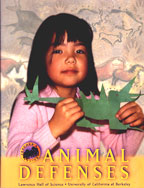Animal Defenses
Grades Preschool—K
Written by Jean C. Echols
If you imagined away an animal's claws (or teeth or horns or stinger),
what would it be? Somebody's lunch, presumably. Beginning with
just such a defenseless imaginary prototype, this highly visual
unit invites children to add protective structures to help "their
animal" cope with the big, predatory world. Using Tyrannosaurus
rex as star predator, the first session introduces the concept
of defense, sparking the idea with classroom dramas and illustrated
encounters. Session 2 elaborates on defensive behaviors,
drawing on such familiar contemporary animals as cats, dogs, and
reptiles to study how defensive mechanisms can include cryptic
coloration, hiding, playing dead, or climbing a tree. Enthusiastic
role-play brings these and other defensive behaviors to life.
This unit is an excellent way to introduce the biological concept
of predator/prey and help young students understand the distinction
between defensive structures and defensive behaviors. The GEMS
guide Hide a Butterfly explores
the concepts of camouflage and predator/prey as they apply to
one insect, making it a natural "zoom-in" follow-up
to this unit.
Time: One 45-minute session, one 20-minute session.
Comment on this GEMS unit. |

Order
online
Ordering Information
Literature Connections
What materials are needed to present this unit? See the full list. |

